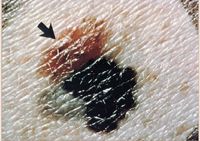- Acne
- Actinic Keratosis
- Aesthetics
- Alopecia
- Atopic Dermatitis
- Buy-and-Bill
- COVID-19
- Case-Based Roundtable
- Chronic Hand Eczema
- Drug Watch
- Eczema
- General Dermatology
- Hidradenitis Suppurativa
- Melasma
- NP and PA
- Pediatric Dermatology
- Pigmentary Disorders
- Practice Management
- Precision Medicine and Biologics
- Prurigo Nodularis
- Psoriasis
- Psoriatic Arthritis
- Rare Disease
- Rosacea
- Skin Cancer
- Vitiligo
- Wound Care
Article
Breakthrough: scientists put melanoma cells into coma-like state
If this research trajectory proves fruitful, he estimates that it will be at least 10 years before dermatologists will be able to use senescence drugs to treat melanoma in a typical practice setting.

The finding comes at a time when melanoma rates are increasing without corresponding advances in efficacious treatment for advanced stages of the disease. Experts suggest the discovery may prove to be a landmark in the understanding of cellular proliferation. It may also lead to less toxic forms of treatment that target cancer cells only, leaving normal cells alone.
Colin Goding, Ph.D., a molecular and cell biologist who led the institute's research team, explains, "We were looking at a gene called Tbx2, which is too active in melanoma and other cancers. We wanted to know exactly what it did and how. Tbx2 turned out to be linked to a mechanism that repressed senescence. What really surprised us was that when we inhibited Tbx2 in melanoma cells, they senesced and stopped dividing."
Future research Previously, scientists thought the senescence mechanism was damaged beyond repair in cancer cells. However, in research recently published in Cancer Research, Dr. Goding's team established that 1) the senescence mechanism could be switched back on and 2) Tbx2 was key to keeping it switched off.
Specifically, they discovered that inactivating Tbx2 molecules induced senescence in CDKN2A-null B16 melanoma cells and displaced histone deacetylase1 (HDAC1) from the p21 promoter. This finding supports previous research that the HDAC function is disrupted in cancer cells, causing inappropriate gene expression and loss of checkpoint control.
In addition to defining a molecular mechanism for transcriptional repression by Tbx2, the team established a link between HDACs and T-box factors - two protein families implicated in loss of cell cycle control. Other studies have shown that inhibiting HDAC activity can arrest cell growth and induce differentiation and apoptosis.
"Researchers are already looking at HDAC inhibitors as anti-cancer agents," Dr. Goding tells Dermatology Times, "but it is difficult to get an effective concentration. There may be better pathways for small molecule inhibition."
Applicability to other cancers Mutations in the INKa and ARF genes at the CDKN2A locus are found in a wide variety of spontaneous cancers. CDKN2A germ line mutations are present in familial melanoma. Tbx2 gene encoding of a key transcription factor is amplified in pancreatic cancer cells and over-expressed in certain breast tumors.
Next step
Dr. Goding has been investigating melanoma for 16 years and senescence for three years. He says the next step is to determine whether the team's findings apply to other cell lines.
"The idea is to use the same techniques to look at as many cancers as possible, first in the lab, then in animal models. Later we can work out the exact mechanism to screen for small molecule drugs."
If this research trajectory proves fruitful, he estimates that it will be at least 10 years before dermatologists will be able to use senescence drugs to treat melanoma in a typical practice setting.









